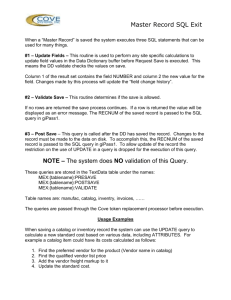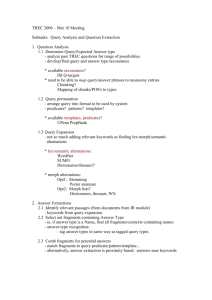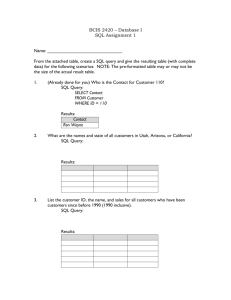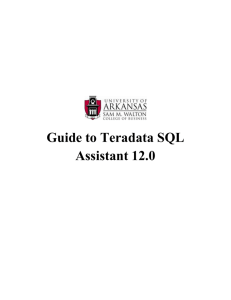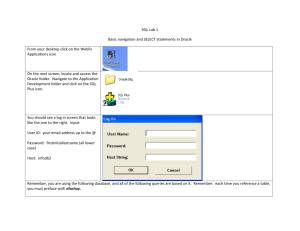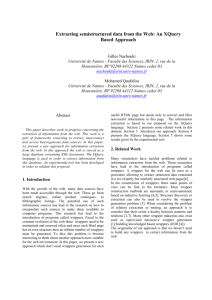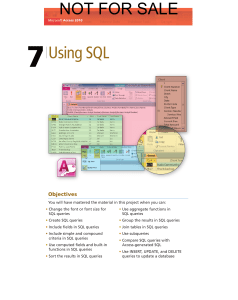Project 4
advertisement
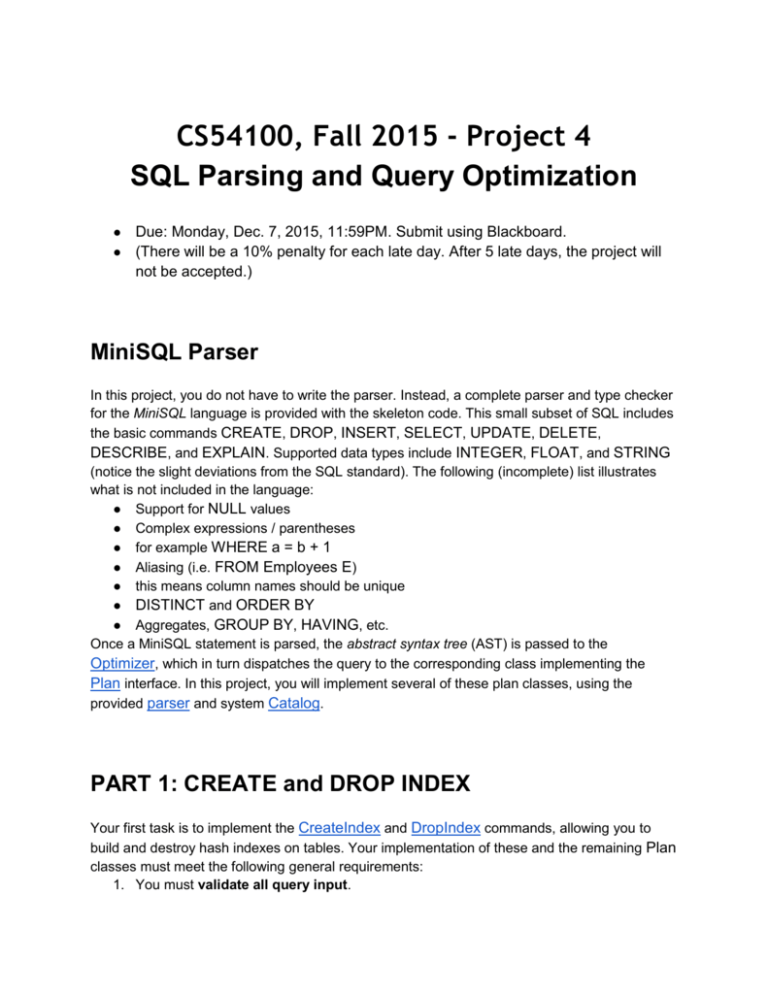
CS54100, Fall 2015 - Project 4
SQL Parsing and Query Optimization
●
●
Due: Monday, Dec. 7, 2015, 11:59PM. Submit using Blackboard.
(There will be a 10% penalty for each late day. After 5 late days, the project will
not be accepted.)
MiniSQL Parser
In this project, you do not have to write the parser. Instead, a complete parser and type checker
for the MiniSQL language is provided with the skeleton code. This small subset of SQL includes
the basic commands CREATE, DROP, INSERT, SELECT, UPDATE, DELETE,
DESCRIBE, and EXPLAIN. Supported data types include INTEGER, FLOAT, and STRING
(notice the slight deviations from the SQL standard). The following (incomplete) list illustrates
what is not included in the language:
● Support for NULL values
● Complex expressions / parentheses
● for example WHERE a = b + 1
● Aliasing (i.e. FROM Employees E)
● this means column names should be unique
● DISTINCT and ORDER BY
● Aggregates, GROUP BY, HAVING, etc.
Once a MiniSQL statement is parsed, the abstract syntax tree (AST) is passed to the
Optimizer, which in turn dispatches the query to the corresponding class implementing the
Plan interface. In this project, you will implement several of these plan classes, using the
provided parser and system Catalog.
PART 1: CREATE and DROP INDEX
Your first task is to implement the CreateIndex and DropIndex commands, allowing you to
build and destroy hash indexes on tables. Your implementation of these and the remaining Plan
classes must meet the following general requirements:
1. You must validate all query input.
2. For example, you should not create an index if the file name already exists. Please
review (and call) the appropriate methods in the provided class QueryCheck to fulfill
this requirement.
3. Execute the query using the components we have developed throughout the semester.
4. If the query affects the system catalogs (i.e. create/drop statements), then call the
appropriate method(s) in Catalog to maintain them.
5. Each query should print a one-line message at the end, such as "Table Created" or "1
row inserted" -- or anything else you would find appropriate.
Some useful hints and tips:
● You may want to use CreateTable and DropTable as a reference.
● (i.e. these are provided to demonstrate how to use the parser)
● Don't forget that CREATE INDEX should actually build the hash index!
● (i.e. don't just rename the word "table" in CreateTable to "index")
Part 2: INSERT, UPDATE, DELETE, and SELECT
Your next task is to implement the Insert and Select classes, allowing you to create and query
actual data. Remember to fulfill the general requirements listed in part one. In addition, you
need to implement the Update, Delete.
For Select, you will implement a basic query optimizer. The parser will give you an array of
table names to select from, an array of (unique) column names to project, and an array of
selection predicates (in conjunctive normal form). The basic plan is to use FileScans and
SimpleJoins for all the tables, add a Selection for each conjunct, and have one Projection at
the root of the Iterator tree.
For example:
Given the tables T1(a, b) and T2(c, d) and the following query:
EXPLAIN SELECT d, a FROM T1, T2 WHERE a = c and b = d or a = 5;
The default (naive) execution plan is as follows:
Projection : {3}, {0}
Selection : b = d OR a = 5
Selection : a = c OR a = 5
SimpleJoin : (cross)
FileScan : T2
FileScan : T1
(Note how the conditions of the WHERE clause change into the predicates)
You need to implement the following optimizations:
1. Pushing Selections: If the predicates of a selection involve only the attributes of one
table, you should execute the selection before the join.
2. Join Ordering: You should maintain catalog statistics (i.e. record counts) and use this
information to determine what order to join the tables.
Some more useful hints and tips:
● Think carefully about any side effects of INSERT and DELETE statements, and how
they affect the catalog counts. Also, what if the table you're inserting/deleting into/from
has indexes?
● The main goal of Select's constructor is to create an Iterator query tree. (i.e. all you
need to do in execute() is call iter.explain() or iter.execute())
For testing purpose, your execution plan will be printed before the returned results.
Getting Started
Here is Project documentation, and Project skeleton code.
Note that this code is a complete starting point for the project, i.e. the bufmgr, heap, index, and
relop packages are provided for you (in jar files). The framework classes may be slightly
different than the ones used in previous projects.
Running and testing this project will be quite different from the others. Instead of using an
automated test driver, you will run the provided command-line utility, Msql, which resembles the
behavior of SQL*Plus. Several test queries are provided with the skeleton code, but more
queries will be tested at the time of grading. Use the STATS command to view performance
counters. The Msql program can receive input from the command line, or from a file. In the latter
case, you need to provide the file name as an input parameter. For example:
java -classpath bin global.Msql mytest.sql
If you use an IDE, feel free to set up your run configuration to accept that input parameter.
Turnin
Only one of the group members should submit the work via Blackboard. Include with your code
the Makefile, Readme (which lists group members, how you do the optimization, new features
that you want us to know, and roles of each member, i.e. who did what). All files need to be
zipped in a file named: your_career_login1_your_career_login2_qe.zip.
We should be able to compile/run your program using make on a CS department Unix machine.
The directory structure of your zip file should be identical to the directory structure of the
provided zip file (i.e., having the directory src, the Makefile, ...), except the top-level name
(should be your career login above). Your grade may be deduced 5% off if you don’t follow this.




